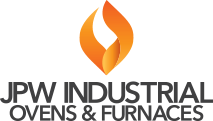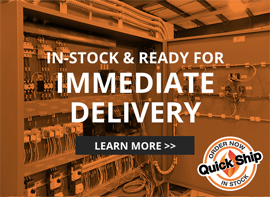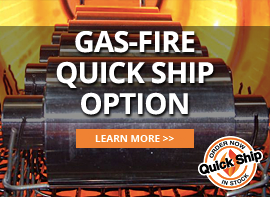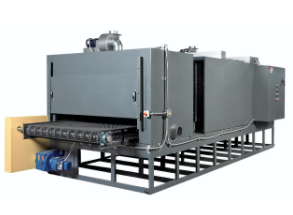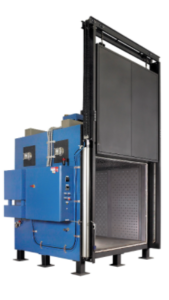Whether it is time to replace an existing industrial batch oven, upgrade a process with a new oven, or set up an entirely new process requiring an industrial batch oven, there are numerous questions that can arise as to how you put together the justification for a capital expenditure. We strongly recommend speaking directly with a sales engineer to narrow your search and help guide you through the process. This will ensure that you limit your risk when selecting your equipment.
Industrial Ovens 101
Some of the basic questions revolve around the oven size, operating temperature, fuel source, available utilities, airflow pattern, instrumentation, and lead time. As a general rule, these are the first questions to get answered; but you will find out that this is just the beginning of a critical exchange of information between yourself and the vendor that will ultimately lead to the proper selection of equipment for your process needs.
Oven size is always a fascinating subject as it pertains to the process. Some feel the oven should be large enough to handle future business opportunities, and others want just enough space to handle current requirements. Usually, the budget for the project helps dictate how far you can go with size. The size is directly relative to what the process needs are. Future business is an unknown and investing in an unknown future revenue stream is a risk. Discuss the detail of your needs with the oven supplier to arrive at a size that will do the job. When selecting a size, remember to discuss any building restrictions that may pose an issue with the size required. Doorways and ceiling heights are the most common issues that can affect how the oven is designed.
Operating temperature has an effect on oven construction. There is a common belief that if you need a 475°F operating temperature, then you should purchase a 650°F unit. There are pros and cons to this theory. Discussing your particular need with your oven vendor will result in a selection that will meet your processing requirements. As a general rule — the higher the temperature, the higher the cost.
The fuel source for the oven can be electric, natural gas, propane, or steam. The first three are the most common. Typically, oven size guides the fuel source selection. Large ovens are cost-effective on natural gas or propane; smaller, low-temperature ovens are cost-effective on electric. There are some processes where only electric can be used. Have your oven supplier discuss the fuel source differences and the cost to operate to determine a cost-effective solution.
Utilities are important to know when purchasing or selecting an oven. Voltage and phase are required whether you are buying a gas oven or an electric oven. Knowing which utilities are available can help determine if you have the proper utilities in place to operate the equipment. The lack of utilities may add to your cost justification if a new gas line or electrical service is required but not identified upfront.
The airflow pattern inside the oven can make your life easy or difficult. Selecting from combination, compound horizontal, straight horizontal, vertical up, or vertical down is truly determined by how you load the oven, taking into consideration its parts, shape, and size. For example, it would be a mistake to load a large stator into a straight horizontal oven where one leading edge of hot air enters the chamber on the right and returns on the left. The hot air will transfer the energy to the right side of the part first, curing it faster than the left side. The proper selection for this example would be combination or compound horizontal with two leading edges of hot air entering the chamber from the left and right side and returning through the top or rear of the oven. Please take airflow into consideration and discuss it with your sales engineer.
Instrumentation is an important topic when selecting a control package for the oven. Controllers range from single set point to profiling, and they can be packaged with a recording option or stand alone. Recording devices come in paper or paperless with many options. The right choices can only be made by using the correct information about the process you are performing. Take time to select the control package that will get the job done and make a point to discuss the options with your sales engineer.
Lead time can only be established once the oven is completely selected and workload schedules for the supplier can be reviewed. This is a variable that is constantly changing. The one thing that we have learned over the years is that everybody will want it faster than it can be built. It is a constant challenge. Consult your salesperson for lead time information.
Specific Process Requirements
Now that you have your size, temperature, fuel source, and other basic needs selected, it is time to gather additional information pertaining to your specific process needs. Paint curing, solvent venting, inert gas processing, composite curing, drying, aging, and annealing are a short list of some of these specific processes. In this section, we will touch on a couple of examples which will help you understand some of the requirements that are crucial to selecting the right oven for your application.
Solvent venting is a common process requirement for industrial ovens whether you are curing solvent-based paints or varnishes. The questions that need attention are processing temperature and the amount and type of solvent being processed. The construction of a solvent venting unit also needs to take into consideration pressure relief panels and an exhaust blower; the unit will also have a purge cycle before allowing the heating circuit to energize. If you have an MSDS (material data safety sheet) for the material you are processing in the oven and the quantity of the material being processed by batch, then the sales engineer can help guide you to the proper selection of a solvent venting oven.
Aging is another common process requirement for industrial ovens. Uniformity and instrumentation are two critical details as aging ovens are used to accelerate the aging process or expose the product to real life conditions through simulation. The process requires the product to get to the target temperature and hold it there uniformly for a specific period of time. Understanding the loading of the product is important so the workspace and airflow pattern are designed to achieve the time to temperature and uniform part temperature specifications required. In some cases, live load testing of the products is required versus an empty chamber survey. Please consult with your sales engineer and communicate your specific needs to select the right equipment and options.
A Working Relationship
The amount of information available to process is astounding and can be challenging when making a decision on your next oven purchase. We have covered a very basic outline that will help get you started, but be sure to discuss in detail your needs with your sales engineer or oven supplier. Ultimately, the relationship between customer and supplier can only be as successful as the information exchanged. Make your next project a success.
